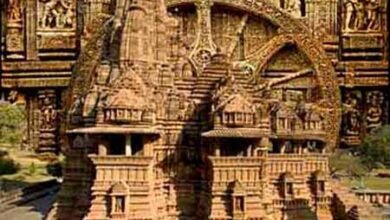
|
1. The distance travelled in unit time is called the speed. 2. The displacement traveled in a fixed direction in unit time is called velocity. 3. Vector quantity signs have both magnitude and directions, while scalar quantity signs have only magnitude. 4. Speed is a scalar quantity, while velocity is a vector quantity. 5. The movement of an object in a certain direction is called displacement. 6. The displacement can be zero but the distance traveled is not zero. 7. The change in velocity per unit time is called acceleration of that body. 8. Acceleration and displacement are both vector quantities. 9. Force is the physical cause that employing on an object changes or changes its state. 10. The force passing a body through an axis: – The tendency to rotate is called force moment. 11. Force moment is a vector quantity and its unit is Newton meter. 12. Angle made by a body at polarity in unit time is called angular velocity. 13. The unit of angular velocity is radians per second (rad / s). 14. According to Newton’s first law of motion, an object is moving, if it is moving and stationary, then it wants to remain stable until an external force acts on it. 15. Newton’s first law of motion is also called the law of inertia. v Due to the inertia of the stop, the passenger bends backwards due to accidentally moving the stopped vehicle, while the inertia of the speed causes the passenger to lean forward when the vehicle stops suddenly. 16. The concept of force is obtained from Newton’s first law of motion. 17. The product of the mass and velocity of an object is called momentum. 18. According to Newton’s Second Law of Motion, the rate of change of momentum of an object is proportional to the force exerted on that object and inversely proportional to mass and the direction of acceleration is in the direction of force, and the direction of acceleration is in the direction of force. it occurs. 19. Newton’s second law of motion gives the expression of force. 20. If a force is acting on an object for a very short time, then the product of force and time is called the impulse of that object. 21. The force which does not result in zero is called unbalanced force. 22. According to Newton’s third law of motion, ‘every action has an equal, but opposite reaction. 23. According to the principle of momentum conservation, if no external force is applied on a group of particles, the total momentum of that body is unchanged. 24. Earth is moving around the Sun or electrons orbiting around a nucleus are examples of centripetal force. 25. The clothes drier and the butter extracting machine work on the principle of centrifugal force.
Prof. Amarendra Kumar. ============ ================= ========== भौतकी से संबंधित-192. महत्वपूर्ण सूत्र…. 1. इकाई समय में तय कि गई दुरी को चाल कहा जाता है. 2. इकाई समय में निश्चित दिशा में विस्थापित दुरी को वेग कहा जाता है. 3. सदिश राशियों के परिणाम और दिशा दोनों होतें हैं, जबकि अदिश राशियों में केवल परिमाण होता है. 4. चाल एक अदिश राशी है, जबकि वेग एक सदिश राशि है. 5. किसी वस्तु द्वारा निश्चित दिशा में स्थान परिवर्तन को विस्थापन कहा जाता है. 6. विस्थापन शून्य हो सकता है लेकिन तय कि गई दुरी शून्य नहीं होती है. 7. वेग में प्रति इकाई समय में होने वाले परिवर्तन को उस पिंड का त्वरण कहते है. 8. त्वरण और विस्थापन दोनों ही सदिश राशियाँ है. 9. बल वह भौतिक कारण है जो किसी वस्तु पर लगकर उसकी अवस्था में परिवर्तन लाता है या लाने कि चेष्ठा करता है. 10. बल द्वारा एक पिंड को एक अक्ष के पारित :- घुमने की प्रवृति को बल आघूर्ण कहा जाता है. 11. बल आघूर्ण एक सदिश राशि है और इसका मात्रक न्यूटन मीटर होता है. 12. किसी पिंड द्वारा इकाई समय में ध्रुवांतर पर बनाया गए कोण को कोणीय वेग कहा जाता है. 13. कोणीय वेग का मात्रक रेडियन प्रति सेकेंड होता है. 14. न्यूटन के प्रथम गति नियम के अनुसार कोई वस्तु गतिशील है, तो वह गतिशील और स्थिर है तो वह स्थिर ही रहना चाहती है जब तक कि उस पर कोई बाहरी बल कार्य न करे. 15. न्यूटन के प्रथम गति नियम को जड़त्व का नियम भी कहा जाता है. v विराम के जड़त्व के कारण रुकी हुई गाड़ी को अकस्मात् चलने से यात्री पीछे की ओर झुक जाता है वहीं, गति के जड़त्व के कारण चलती हुई गाड़ी को अचानक रुकने पर यात्री आगे की ओर झुक जाता है. 16. न्यूटन के प्रथम गति अवधारणा से बल की परिभाषा प्राप्त होती है. 17. किसी वस्तु के द्रव्यमान और वेग के गुणनफल को संवेग कहा जाता है. 18. न्यूटन के द्वितीय गति नियम के अनुसार, किसी वास्तु के संवेग में परिवर्तन की दर उस वस्तु पर आरोपित बल के समानुपाती तथा द्रव्यमान के व्यत्क्रमानुपाती होता है, और त्वरण की दिशा बल की दिशा में होती है, और त्वरण की दिशा ही बल की दिशा में होती है. 19. न्यूटन के द्वितीय गति नियम से बल का व्यंजक प्राप्त होता है. 20. यदि कोई बल किसी वस्तु पर बहुत ही कम समय तक कार्यरत रहे तो बल और समय के गुणनफल को उस वास्तु का आवेग कहा जाता है. 21. जिस बल का परिणाम शून्य नहीं होता है, उसे असंतुलित बल कहा जाता है. 22. न्यूटन के तृतीय गति नियम के अनुसार ‘प्रत्येक क्रिया के बराबर , परन्तु विपरीत दिशा में प्रतिक्रिया होती है. 23. संवेग संरक्षण के सिद्धान्त के अनुसार यदि कणों के किसी समूह पर कोई बाह्य बल नहीं लग रहा हो तो उस निकाय का कुल संवेग अपरिवर्तित होता है. 24. पृथ्वी का सूर्य के चारो ओर घूमना या इलेक्ट्रान का नाभिक के चारो ओर घूमना अभिकेन्द्रीय बल का उदहारण है. 25. कपडा सुखाने की मशीन तथा दूध से मक्खन निकालने वाली मशीन अपकेन्द्रिय बल के सिद्धान्त पर कार्य करता है. प्रो. अमरेन्द्र कुमार.
|






